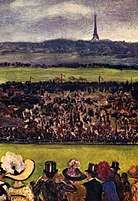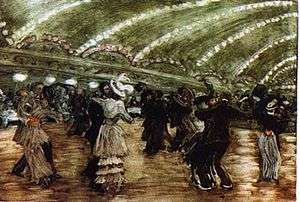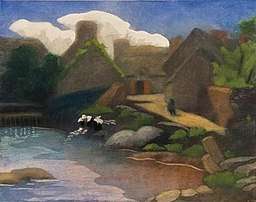Elizaveta Kruglikova

Elizaveta Sergeyevna Kruglikova (Russian: Елизавета Сергеевна Кругликова; 19 January 1865 – 21 July 1941) was a Russian-Soviet painter, etcher, silhouettist and monotypist.
Biography
She was born in Saint Petersburg to a military officer who was an amateur painter. Her grandfather, Nikolai Kruglikov (1788–1868), was a professional painter. In 1880, she lived with her father in Poltava, where she first met artists associated with the Peredvizhniki and decided on art as a career. From 1890 to 1895, she audited classes at the Moscow School of Painting, Sculpture and Architecture, where she studied with Illarion Pryanishnikov, Sergei Korovin and Abram Arkhipov.[1]
In 1895, she continued her studies in Paris at the Académie Colarossi and the Académie Vitti.[2] She set up her own studio in 1900 and, from 1902, studied etching with Joseph-Victor Roux-Champion (1871–1953). After 1909, she was also a teacher at the Académie de La Palette.[1]

At the beginning of World War I, she returned to Saint Petersburg and became associated with Mir Iskusstva. In 1916, she published a book of monotypes called Paris on the Eve of the War and donated the proceeds to Russian artists who were stranded in France.[1]
In 1919, she was one of the founders of the State Puppet Theater; a predecessor to the State Central Puppet Theater established by Sergey Obraztsov in 1931. From 1922 to 1929, she was a Professor at the Higher Art and Technical Studios (formerly the Imperial Academy of Arts), where she taught theatrical and decorative painting. She also designed posters and published a popular series of silhouettes, Poets, followed by another on Leaders of the Revolution.[2]
A prolific exhibitor, she participated in virtually all of the shows held in the Soviet Union as well as several abroad, including the Venice Biennale (1928).[1] Inactive throughout much of the 1930s, she went to Moscow in 1939 to help organize an exhibition featuring works by the former members of Mir Iskusstva.
She was known for reviving older etching and printing techniques, such as the mezzotint and aquatint, but was especially well known for monotypes.[2] In 2009, the Fourth International Festival of Monotypes was dedicated to her.
She died on 21 July 1941 in Saint Petersburg.
Other selected works
 Horse Race (monotype)
Horse Race (monotype) Tango at Luna Park (monotype)
Tango at Luna Park (monotype).jpg) The Senate Building in Winter (mezzotint)
The Senate Building in Winter (mezzotint) Pond at Pont-Aven (aquatint)
Pond at Pont-Aven (aquatint)
References
- 1 2 3 4 Brief biography @ RusArtNet.
- 1 2 3 Brief biography @ Russian Paintings.
Further reading
- Pyotr Kornilov, Елизавета Сергеевна Кругликова. Жизнь и творчество (Life and Works), Художник РСФСР, 1969
External links
| Wikimedia Commons has media related to Elizaveta Kruglikova. |